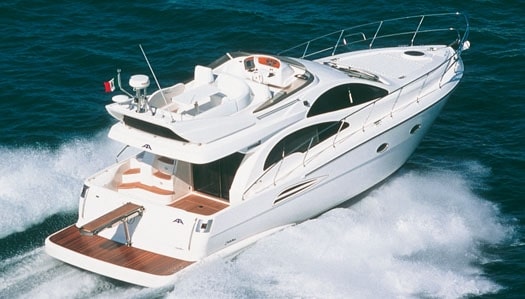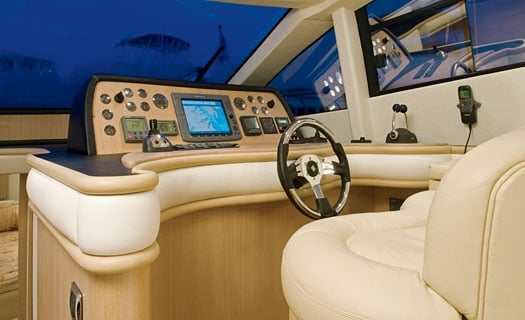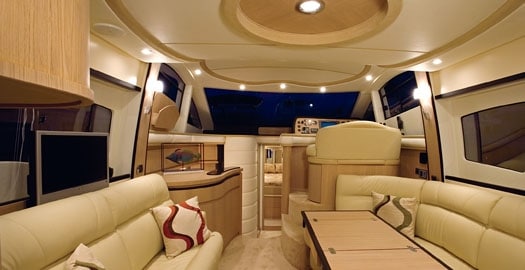
astandoa431.jpg
In the utterly self-possessed style of a child prince from a royal family, the Astondoa 43 motoryacht keeps you in your place, but in a good way. You’ll be snug, safe, and envied on board because the 43 is stylish, solidly constructed, and spacious. It is also quiet and friendly. Under way, for example, the yacht seems to work with the sea, instead of fighting it, and its Volvo IPS power package doesn’t require a pedigree, bolstering a helmsman’s confidence-a confident helmsman equals happy passengers. Even a short time aboard had me wishing I could point the bow toward the horizon and parts unknown.
I saw this Spanish motoryacht for the first time at the Newport International Boat Show in September, 2007. Struggling for breathing space among the yachts of similar size and configuration surrounding her, the Astondoa 43 flaunted her origin and pedigree via a hydraulically operated passerelle of polished stainless steel and teak- a Victorian lady’s perfect bustle-hovering above the massive teak-paved swim platform. In spite of the throng of jolly shoppers shuffling through the yacht, I noticed the molded-in staircase to the flying bridge, wide side decks and her creamy free-form décor in the saloon. Then and there I decided to get better acquainted with this intriguing Spaniard and her builder.
Although Astondoa was new to me, Jesus Astondoa founded the company that bears his name in 1916. Like most Old World craftsmen of the period, he relied for success on dedication to high-quality construction and an ability to listen to his clients. Now under the leadership of Jesus Astondoa SantaMaria, Grupo Astondoa follows the same principles its founder established, and employs its seven branches to reach a common goal-the best yachts it knows how to produce. Today, Astondoa builds a line of composite yachts of 40 to 82 feet LOA, in open or motoryacht configurations, and a series of custom aluminum yachts to 138 feet LOA. All of the models share many of the company’s exterior styling elements, which reinforces the Astondoa look, and even the smallest yacht in the production line enjoys the careful design and workmanship that goes into the superyachts.
Sound Yachting Group, in Westbrook, Conn., is the U.S. distributor for Astondoa, and that’s where I caught up to the 43. Like most yachts of this length, the 43 gets a lot of her interior volume from the beam (a third of the yacht’s length on deck in this case), the hull’s freeboard, a reverse sheerline and raised foredeck. This is dangerous territory, because the result can be bulbous and unattractive. Not so the Astondoa 43. The design team has successfully disguised the height of the freeboard with a straight character line that divides the topsides and attracts our attention to the three elliptical portlights and the elongated teardrop vent to the engineroom. The rub rail traces the reverse sheerline to the break at the forward end of the cockpit and helps reduce the yacht’s visual bulk.

| | |
The designers have divided the superstructure into a couple of semi-elliptical segments; in profile, this resembles the French curve made famous in the 1930s by Jean Bugatti’s design of the Bugatti Atlantique Coupe´. The coachroof rises at a graceful rake, recalling aerodynamic roofline of an expensive sports car. This stylistic sophistication is echoed belowdecks, where she felt distinctly adult to me in her décor. The angle of rake and the single-piece windshield remind us that the 43 is fast and sporty for a cruising motoryacht. As the superstructure narrows this, too, reduces visual bulk and only slightly diminishes the play space on the flying bridge. Owners will never miss the square footage. But they’d certainly object to the styling if the area were wider and had a conventional radar/antenna arch.
Among all of the elements that went into making the Astondoa 43 look sleek and stylish, my favorite is the tumblehome in the superstructure. It makes the yacht seem compact and lets adults walk along the wide side decks without being forced to lean outboard. This small detail returns huge benefits in safety. Bravo Astondoa.
Astondoa hasn’t left any doubt about the 43’s role as a luxurious cruising boat for a couple alone, with two guests or two children. The saloon’s creamy soft leather upholstery, lighter shade of suede, and light oak cabinetry embraced me like a gracious hostess. You won’t find more than a handful of straight lines and right angles, yet plenty of stowage space lurks within.

| | |
The master stateroom in the bow has an en suite head on the port side forward of the galley. The guest stateroom on the starboard side opposite the galley has a private entrance to a head reached by a second door.
For a genuine boating enthusiast, the proof of any yacht’s value lies in its behavior under way. Ian Vale, president of the Sound Yachting Group, was my captain and tour guide aboard the 43. When he fired up the Volvo Penta IPS-600 diesels, he apologized for the low-frequency throb that we felt through the cockpit sole. This is the result of the exhaust exiting the big engines through the hub of each IPS drive. The throb completely disappears as soon as you get under way, even at idle speed. Using the IPS joystick, Vale moved us off the dock directly sideways and then eased the boat forward out of the marina. We operated the boat from the flying bridge, where my sound meter showed 58 db(A) at idle-extraordinarily quite.
Out in Long Island Sound, Ian opened the throttles. The acceleration astonished me. He slowed and performed the bag of tricks that makes low-speed maneuvering via IPS so easy-and amusing. Then we dashed off for another high-speed run, turning this way and that, in tighter circles than I ever thought possible for a boat of this size. He turned over the helm to me so I could repeat the antics. Although the steering at first felt numb I soon became accustomed to it and learned to appreciate its ease of motion. As so often happens in these tests, the wind was light and the seas nearly flat. Crossing our wake, though, showed off the Astondoa’s solid construction. Nothing rattled, croaked or banged, and the ride was as smooth as you could ever want.
The price of the Astondoa fluctuates with the value of the Euro versus the US dollar, but their high-quality construction, attention to detail and willingness to accommodate buyers wishes ought to open a lot of wallets this side of the Atlantic.








